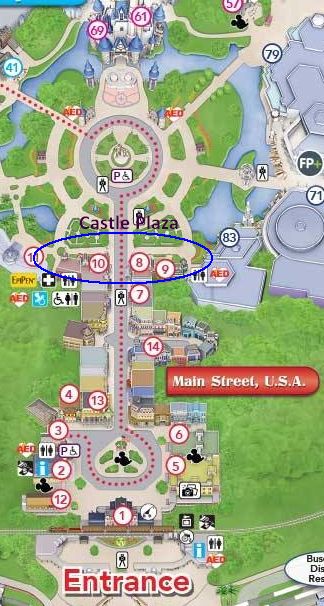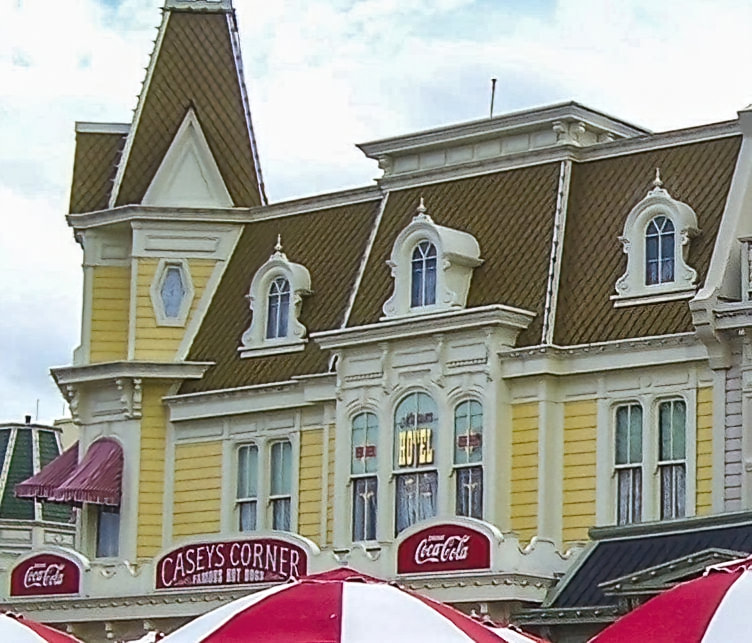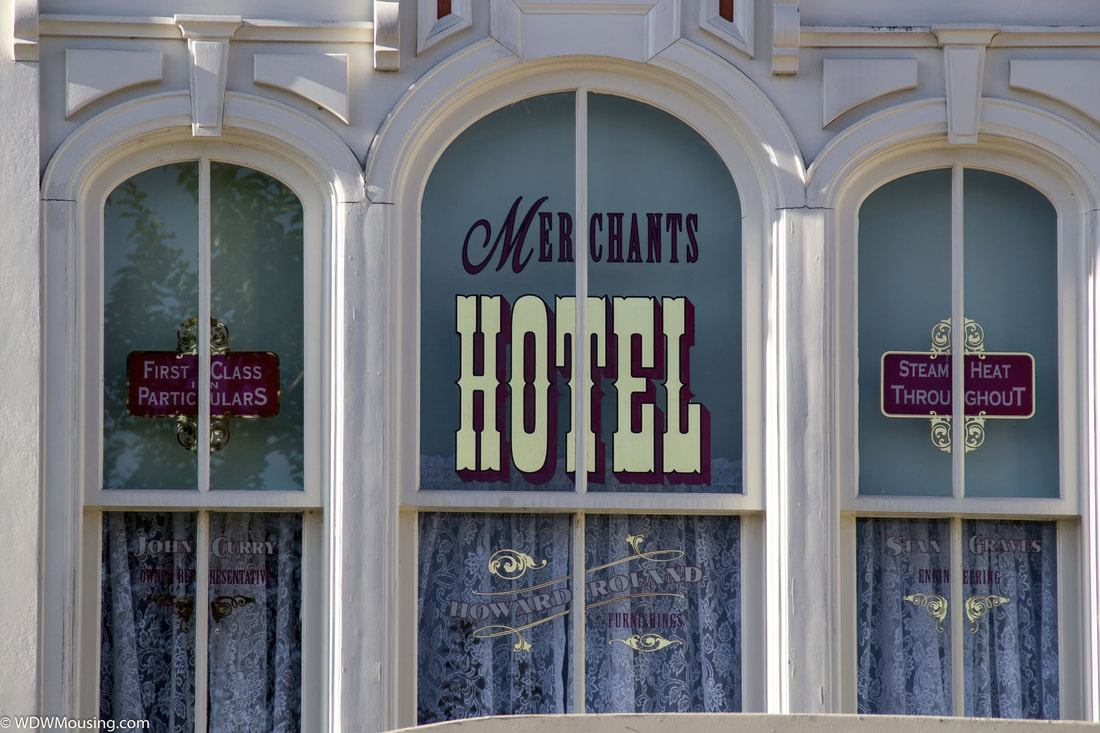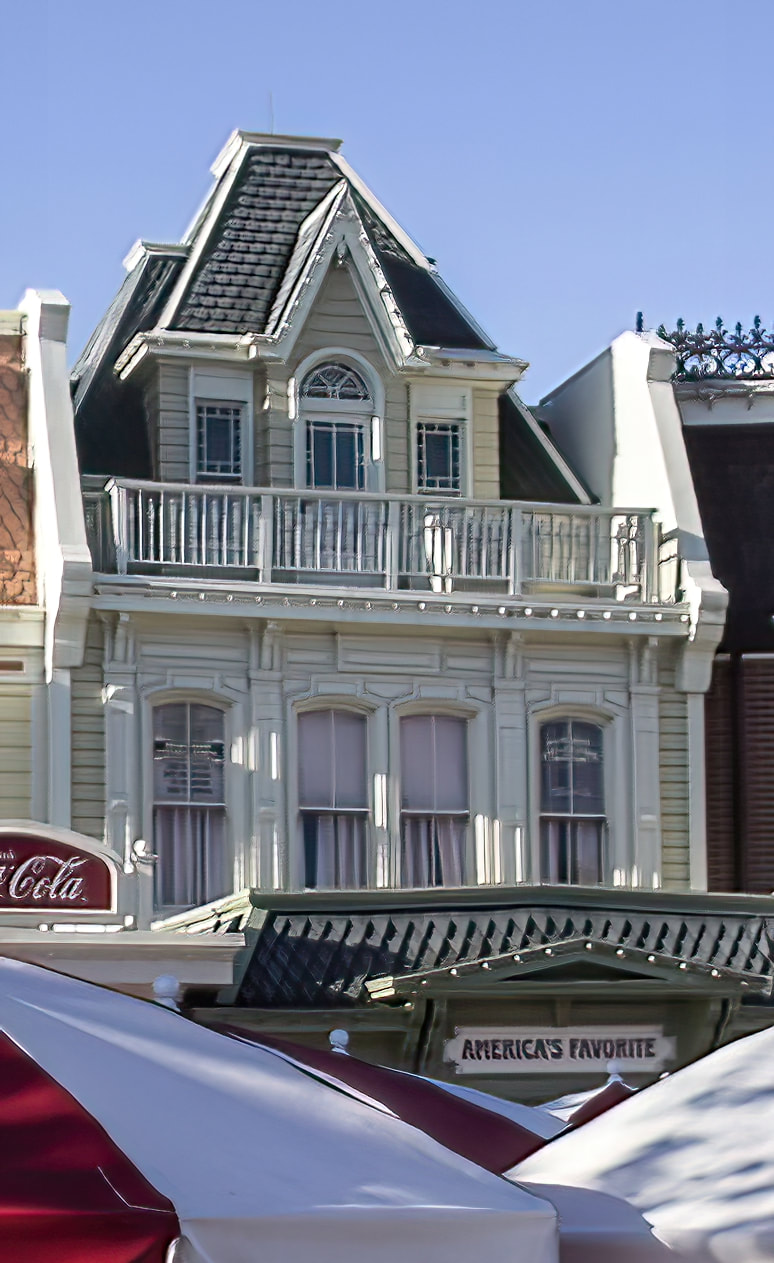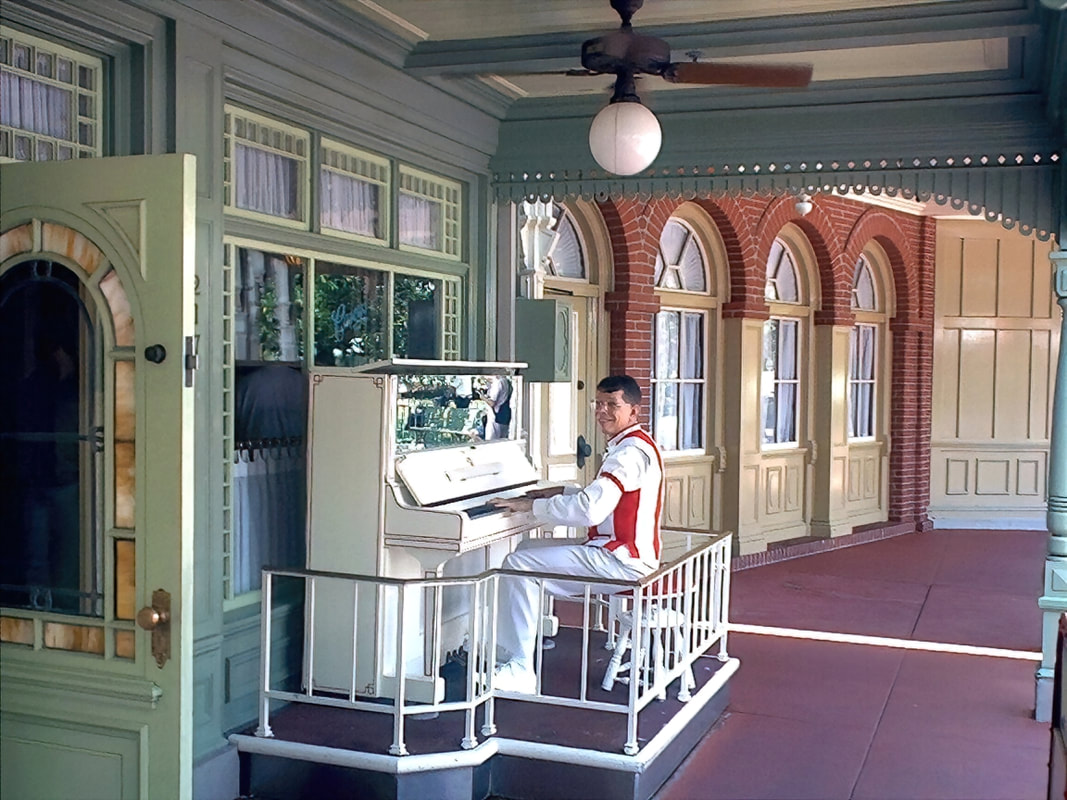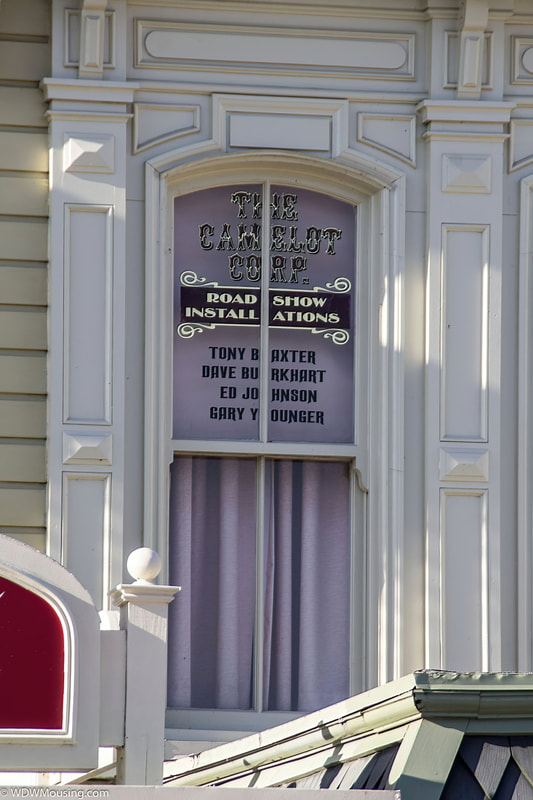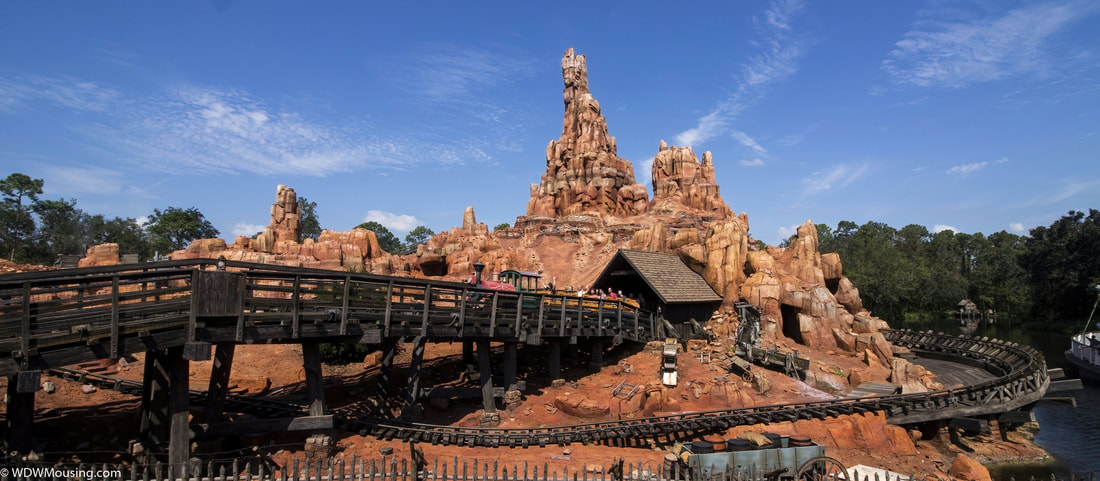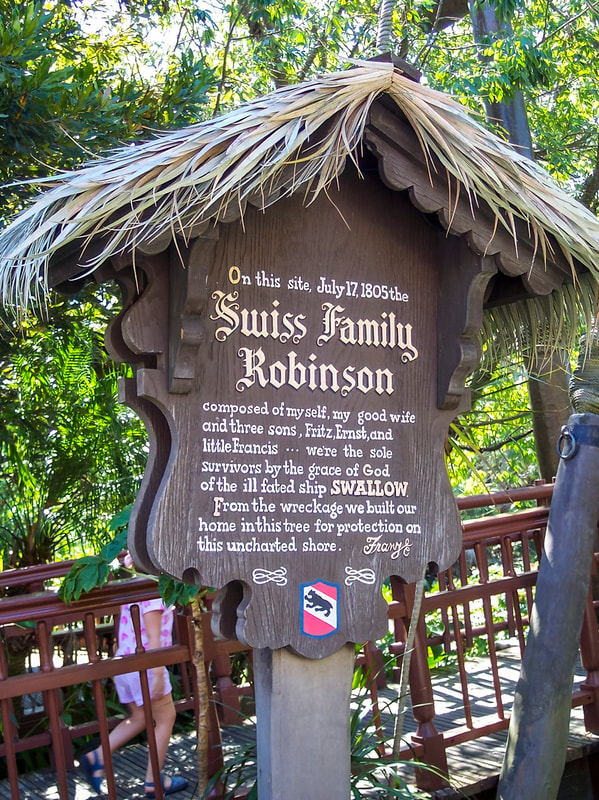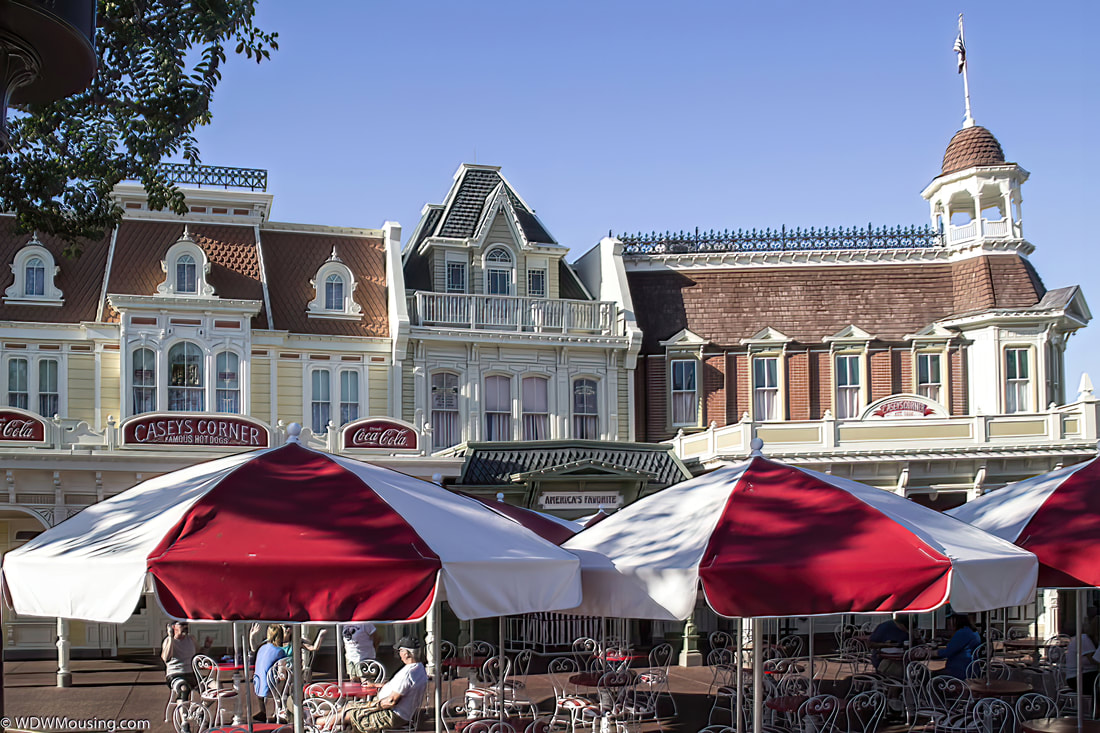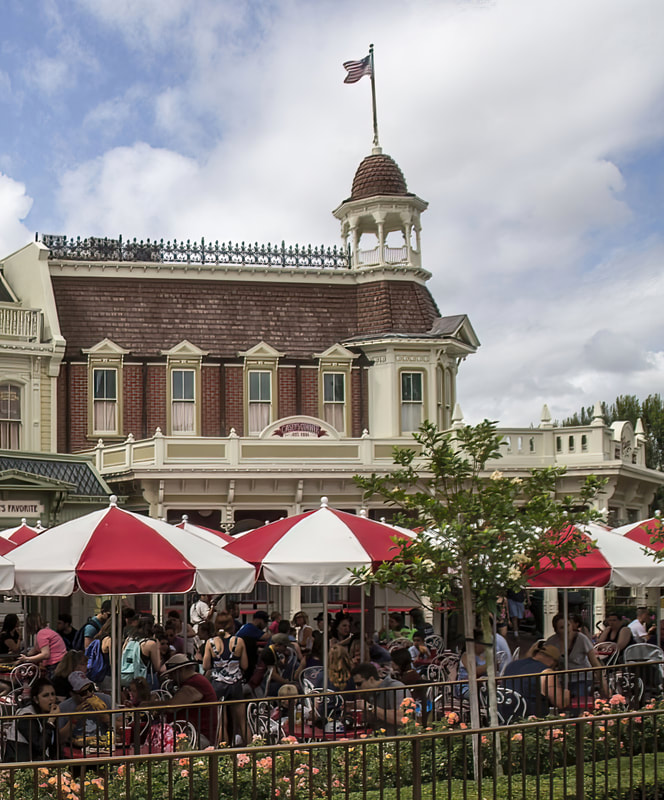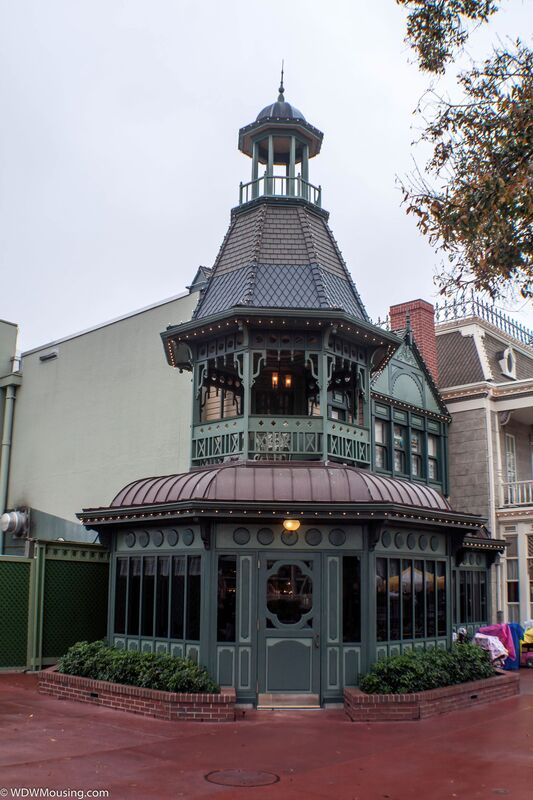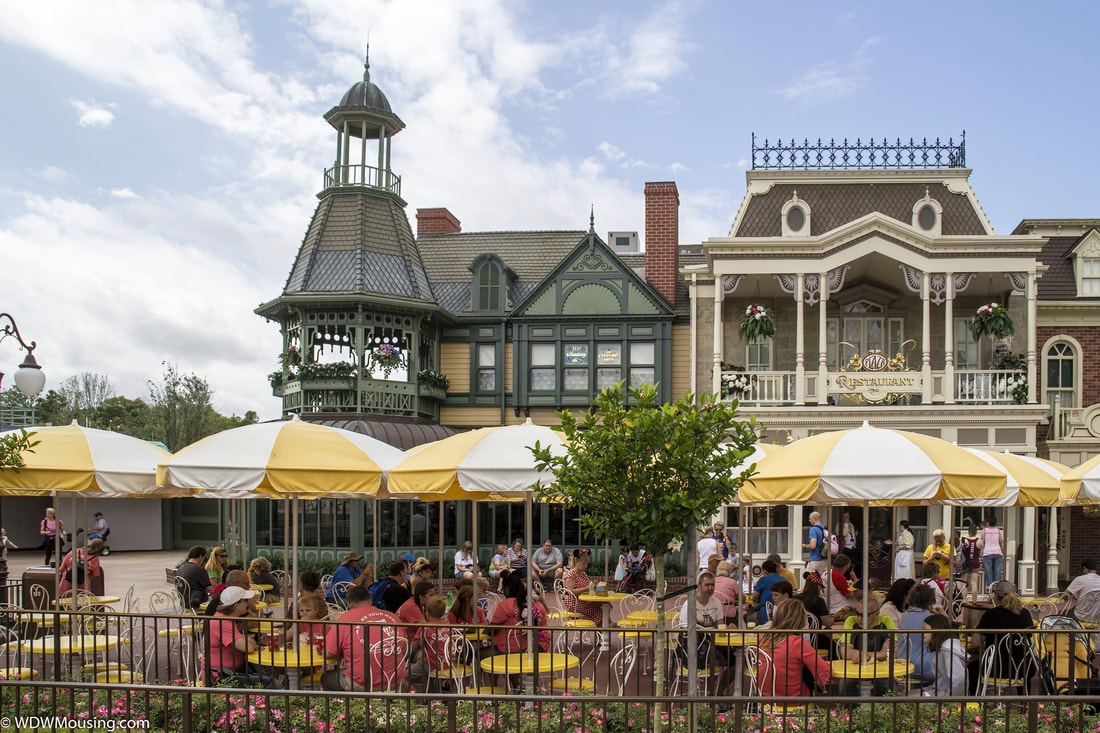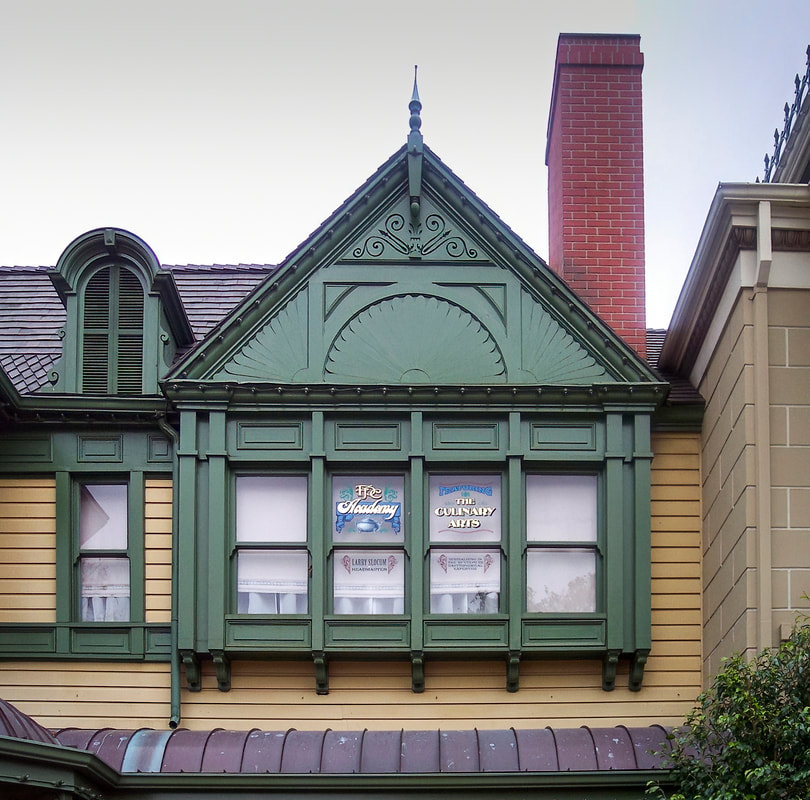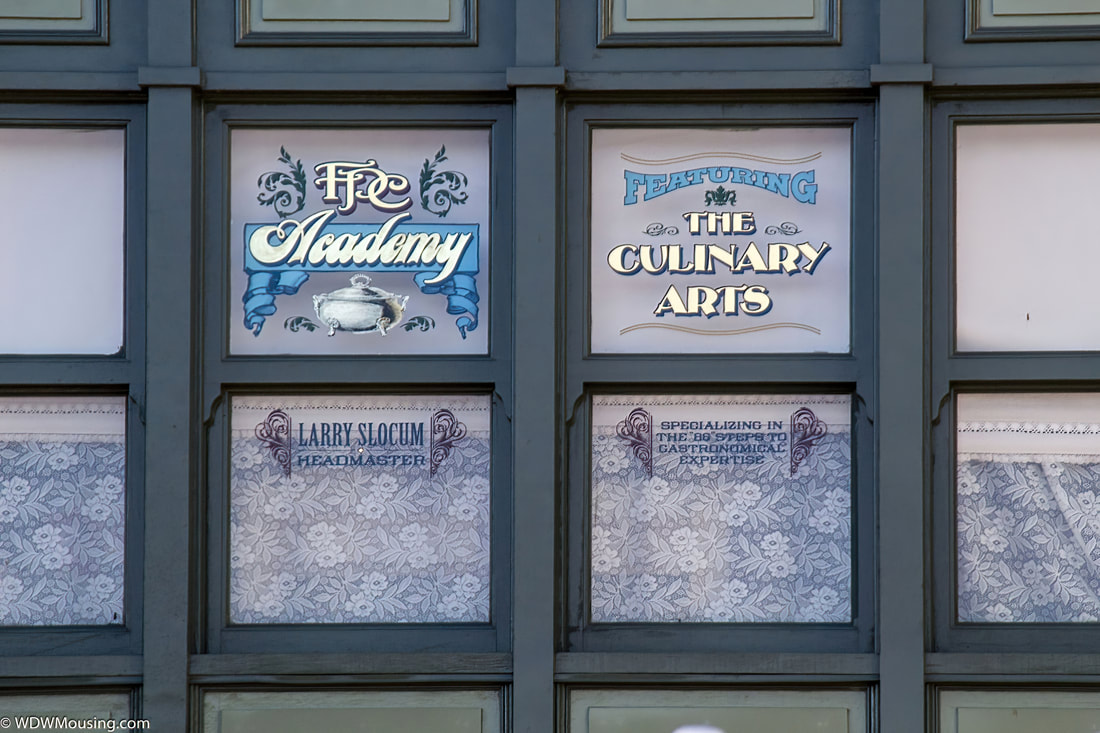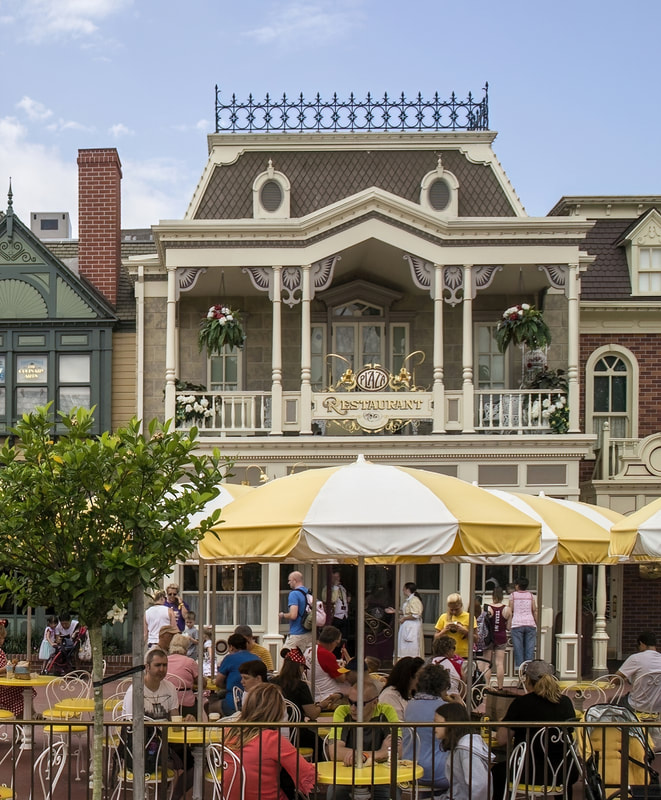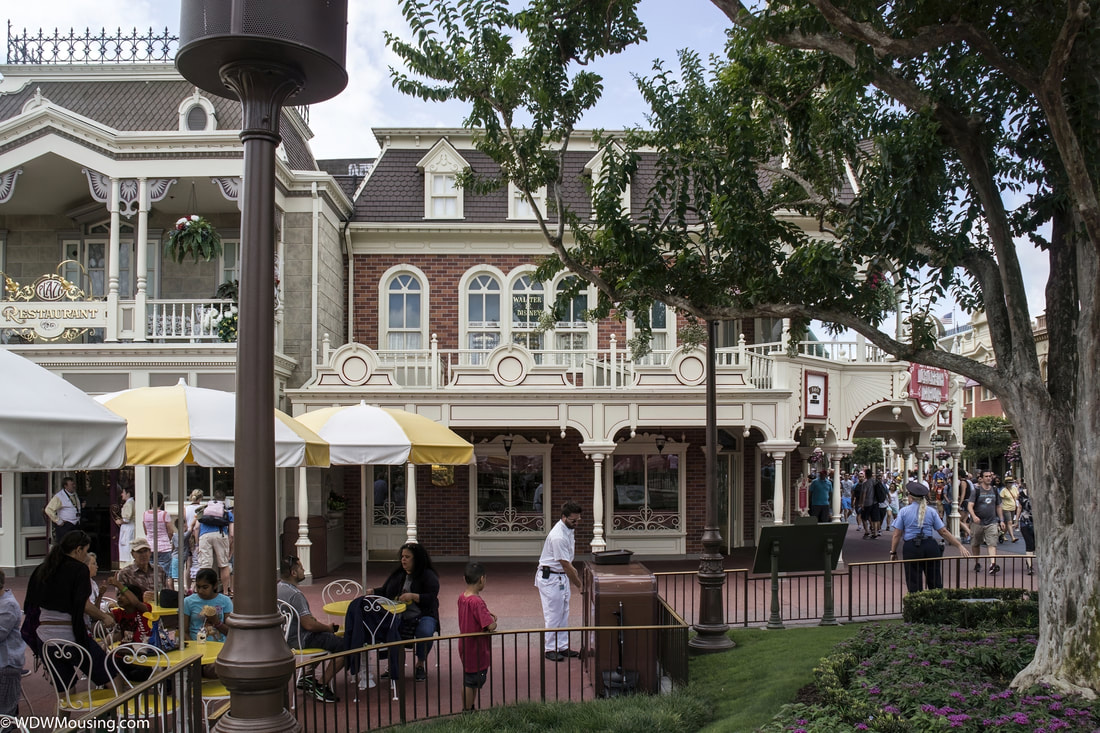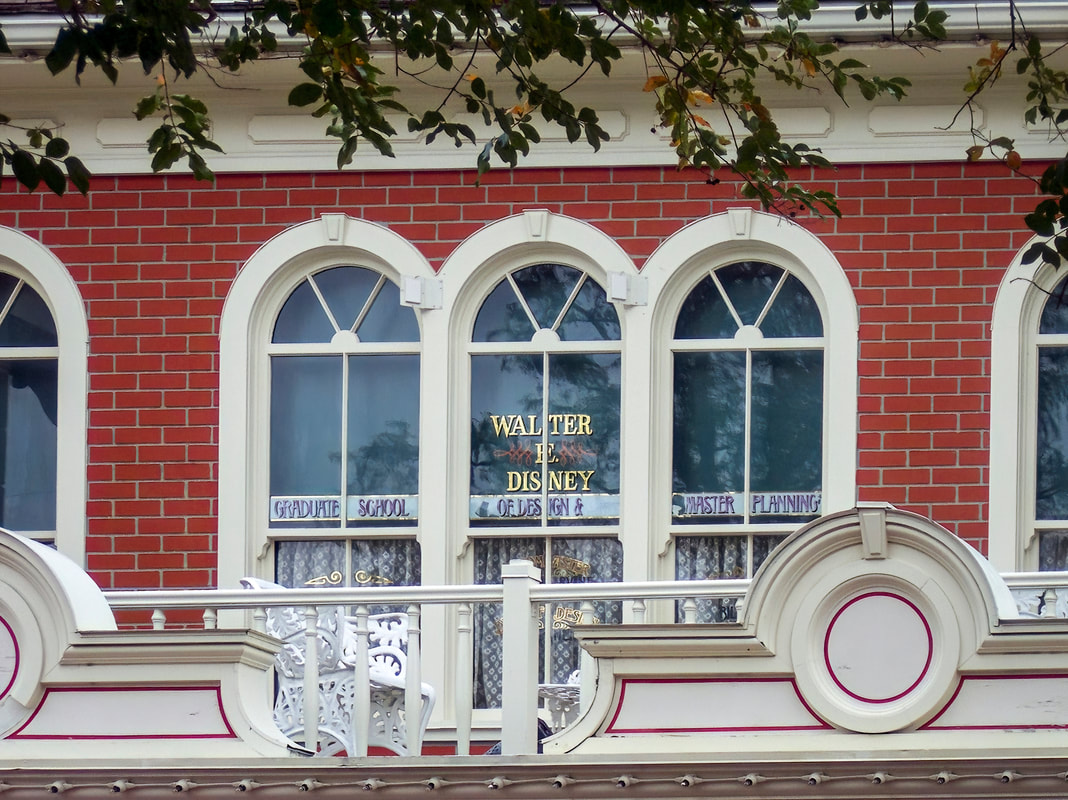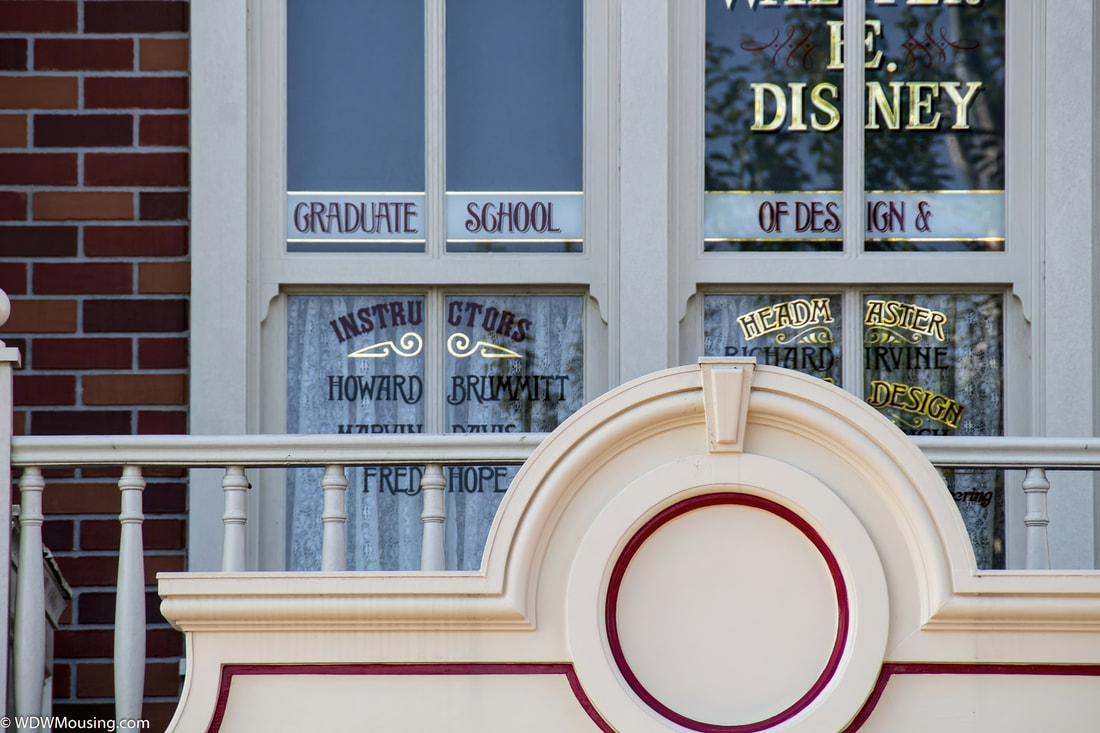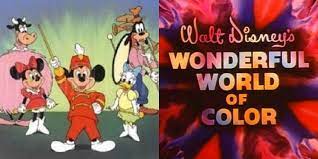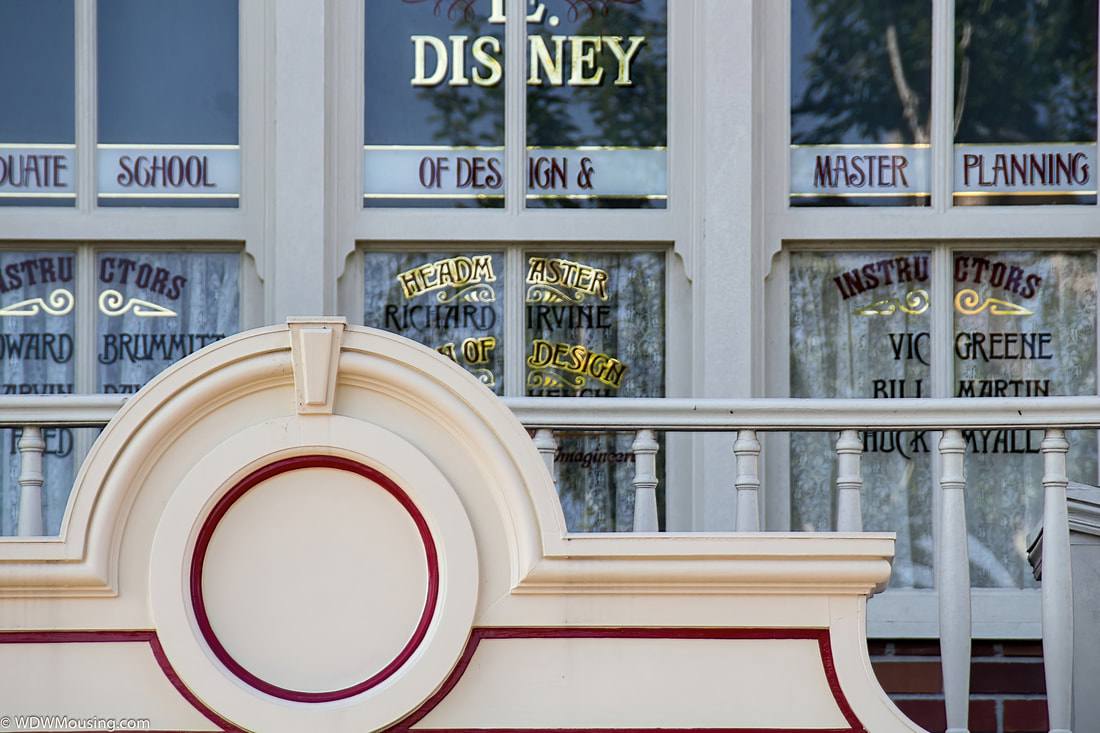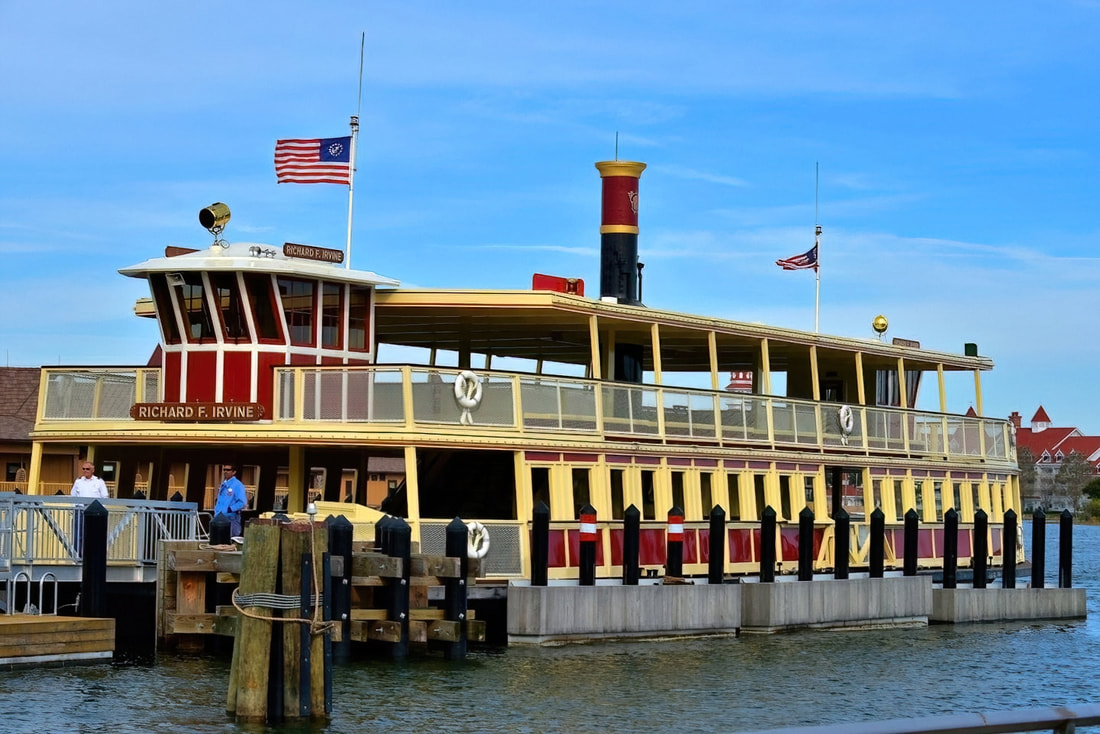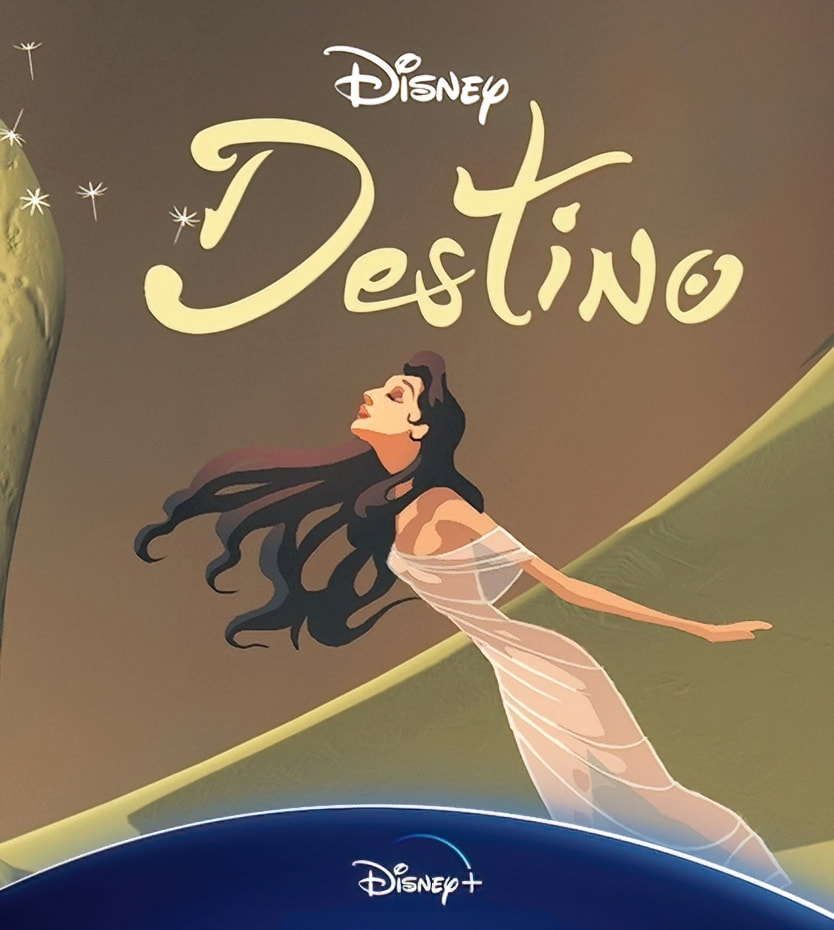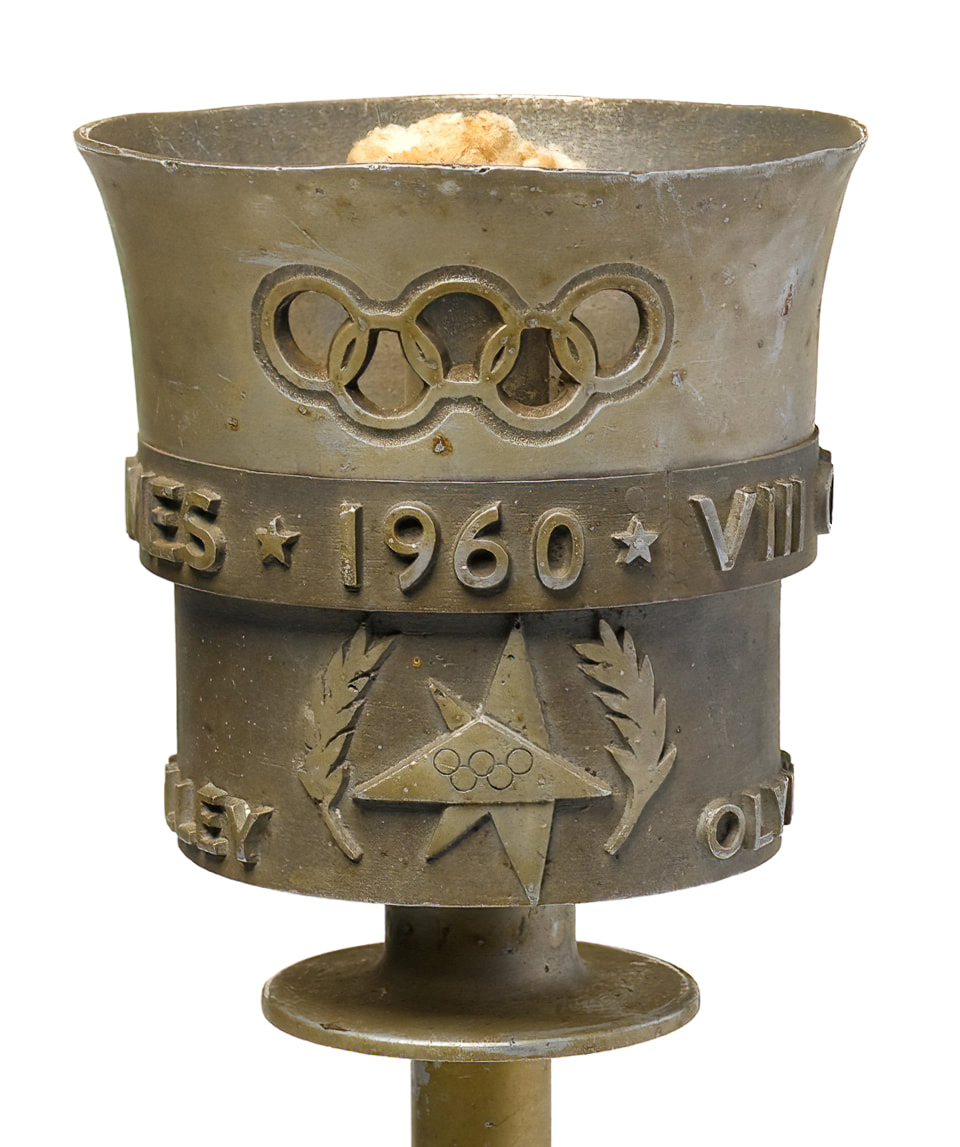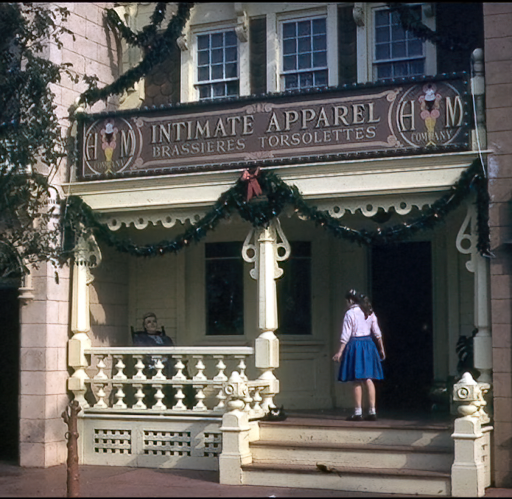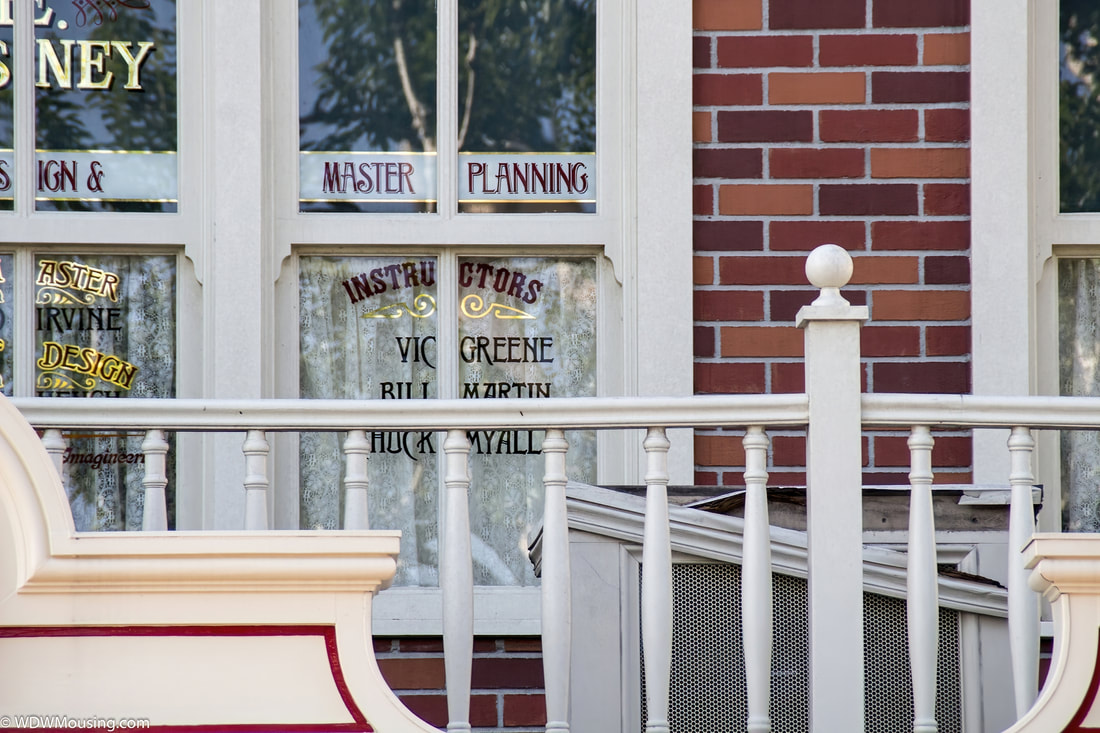Chapter 40- Magic Kingdom - Windows on Main St. USA - Castle Plaza - Part 5 posted Jan 2022
This is the final Chapter on the Windows on Main St. USA series. We have worked on this project for over 2 years in order to provide the most accurate and complete details of the Imagineers and Legends that have earned a dedication on Main St, USA at the Magic Kingdom in Walt Disney World.
As we conclude with this Chapter, we continue around the corner at Casey’s to continue our tour of the Windows on Main St.
As we conclude with this Chapter, we continue around the corner at Casey’s to continue our tour of the Windows on Main St.
Above Casey’s Corner restaurant outside seating area, facing the Castle Plaza, are a set of windows but only the center triple window has dedications.
The Walt Disney Company's first hotel executive team is honored in these windows.
The tributes read:
|
First Class Particulars John Curry Owner Representative |
Merchants
Hotel Howard Roland Furnishings |
Steam Heat Throughout Stan Garnes Engineering |
This was the team in charge of getting the hotels up and running.
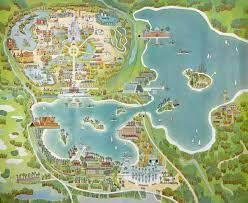 Pre - 1971 Conceptual Map
Pre - 1971 Conceptual Map
John Curry - Disney met Curry in the 1960s at Yosemite, where Disney was scouting opportunities to build a Mineral King hotel and ski park. John had the distinction of being the first hotel employee hired by Walt Disney in August of 1966.
He worked with architects to conceive, construct, and operate the Contemporary and Polynesian resorts. He researched hotels across the country, worked with U.S. Steel Corp. on the construction, and hired the first executive hotel staffs.
Curry and his team laid groundwork for five Orlando hotels, including three that were never built: the Asian, the Venetian and the Persian.
Howard Roland - Originally working for US Steel (the company hired to build the Contemporary and Polynesian Village Resorts) Howard Roland left to join Disney. He was the Vice President of Construction Contract Administration and Purchasing.
Stan Garnes - was an Imagineer with The Walt Disney Company. (Research continues)
Trails:
Stan Garnes - was an Imagineer with The Walt Disney Company. (Research continues)
Trails:
There are no other tributes to Legends or Imagineers on the surrounding or third floor windows.
As we move further down and look at the windows over Casey’s piano area. (Above the “America’s Favorite” sign)
The left window is dedicated to:
|
The Camelot Corp. Road Show Installations Tony Baxter Dave Burkhart Ed Johnson Gary Younger Tony Baxter - Baxter began his professional Disney career in 1965 while completing his education at California State University, Long Beach, graduating in 1969 with a bachelor’s degree in theater design. In 1970 he was hired by Walt Disney Imagineering as a dimensional designer. He was sent to Florida to work on the Walt Disney World Resort, which opened in 1971. Tony was assigned to take the lead on projects for both Walt Disney World in Florida and Disneyland, his first assignment work on Frontierland. Claude Coats took Tony under his wing and helped him develop Tony’s first popular attraction – Big Thunder Mountain. |
Since then, Tony has designed numerous attractions including: Big Thunder Mountain Railroad (Opened in 1979 at Disneyland), Re-design of Disneyland’s Fantasyland (Opened in 1983), the original Journey Into Imagination pavilion (Opened in 1983), Star Tours (Opened in 1986 at Disneyland), The Disney Gallery (Opened in 1987), Splash Mountain (Opened in 1989 at Disneyland), Disneyland Paris (Opened in 1992), Indiana Jones Adventure (Opened in 1995 at Disneyland), Re- design of Disneyland’s Tomorrowland (Opened in 1998), Finding Nemo Submarine Voyage (Opened in 2007), Re-design of Disneyland’s Sleeping Beauty’s Castle Walkthrough (Opened in 2008), The Little Mermaid: Ariel’s Adventure (Opening in 2010), and Radiator Springs Racers (Opening in 2012).
Never-built projects that Tony personally supervised include a re-design for Disneyland’s Tomorrowland called Tomorrowland 2055 (See Magic Kingdom Chapter 25 Tomorrowland – Part 1) and a new land for Disneyland called Discovery Bay. (However, this was a source of inspiration for Discoveryland in Disneyland Paris—that park’s version of Tomorrowland.)
Today, Baxter retired in 2013 as Senior Vice President, Creative Development, Walt Disney Imagineering, and is responsible for overall creative direction for the Disneyland Resort.
Never-built projects that Tony personally supervised include a re-design for Disneyland’s Tomorrowland called Tomorrowland 2055 (See Magic Kingdom Chapter 25 Tomorrowland – Part 1) and a new land for Disneyland called Discovery Bay. (However, this was a source of inspiration for Discoveryland in Disneyland Paris—that park’s version of Tomorrowland.)
Today, Baxter retired in 2013 as Senior Vice President, Creative Development, Walt Disney Imagineering, and is responsible for overall creative direction for the Disneyland Resort.
#
|
Dave Burkhart - began his career with Disney in 1967 serving as an artist model maker, building architecture and show models, including some full-scale sets and props. He subsequently became a show designer and field art producer. He was responsible for show, ride, and facility concepts through show installation at Disneyland and Walt Disney World, for such attractions as the Haunted Mansion, Swiss Family Tree House, and 20,000 Leagues Under the Sea.
In 1974, Dave became Superintendent of Decoration at Disneyland, responsible for the maintenance of the Park’s Day to day “show aspects” and the design interface with Imagineering. He was later promoted to Manager of Buildings and Grounds, where he was responsible for Decorating, Landscaping, Carpentry, Fiberglass, and the Paint/Sign departments, supervising a staff of over 200 artists and crafts professionals. Dave was assigned to the Tokyo Disneyland Project in 1984, where he developed the Show Quality Assurance Program for the project and trained the Japanese management staff in show quality to assure the ongoing maintenance of the original design intent for the Park. He was also responsible for the planning, purchasing and installation of the interiors and props programs for the Parks, as well as serving as counterpart Maintenance Director for the pre- and post-opening period. He eventually was promoted to Vice President of Imagineering’s international Show Quality Standards effort, and served as Executive Producer for the Disneyland Portfolio. Besides the window on Main St, he is also immortalized on a Haunted Mansion tombstone. |
#
Ed Johnson - was a project show designer for Walt Disney Imagineering (WDI) and worked in the model shop. (Still researching)
#

Gary Younger was a director of MAPO for WDI, a production director for WED Enterprises/WDI, and was a system developer. One of his duties was to oversee the making of the new audio animatronics including the singing robin from Mary Poppins movie.
Resources:
- https://en.wikipedia.org/wiki/Tony_Baxter
- https://d23.com/walt-disney-legend/tony-baxter/
- https://www.endorexpress.net/star-wars-adventures/star-tours/2013/11/tony-baxter-gets-his-window-on-main-street/
- https://www.apogeeattractions.com/why-apogee/team-12/david-burkhart/
- https://hauntedmansion.fandom.com/wiki/Dave
- https://www.worldofwalt.com/main-street-usa-tribute-windows-imagineers.html
The middle two windows are blank, but the right window has a tribute to:
In 1965, Ralph designed the first limited-edition Mickey Mouse watch for adults. Walt gave his top 25 executives one of those watches. People started to hear about this unique watch that everyone wanted one.
For the opening of Disney World, he designed souvenirs such as license plates, bumper stickers, and more.
Kent was the man behind Mickey’s signature. For a while he was one of a scant few authorized to sign the mouse’s signature.
He became Director of Walt Disney Imagineering East and then in 1990, Ralph was named the corporate trainer of Disney Design Group that mentor new artists. His work ensured characters would be drawn uniformly, particularly the group known by some as the “Fab Five”: Mickey Mouse, Minnie Mouse, Donald Duck, Goofy and Pluto.
For the opening of Disney World, he designed souvenirs such as license plates, bumper stickers, and more.
Kent was the man behind Mickey’s signature. For a while he was one of a scant few authorized to sign the mouse’s signature.
He became Director of Walt Disney Imagineering East and then in 1990, Ralph was named the corporate trainer of Disney Design Group that mentor new artists. His work ensured characters would be drawn uniformly, particularly the group known by some as the “Fab Five”: Mickey Mouse, Minnie Mouse, Donald Duck, Goofy and Pluto.
Info:
Just as the two middle windows on the second floor were blank, so are the third-floor windows, just waiting for more dedications.
There are also no inscriptions on the second floor windows above of the end building of Casey’s Corner.
There are also no inscriptions on the second floor windows above of the end building of Casey’s Corner.
Now we’re finished with the West side of the Windows facing the Castle Plaza, we’ll head over to the East side and start with the windows at the far end over the Plaza Restaurant.
The second floor over the Plaza Restaurant has 5 windows. One small one and next to it is a set of four larger windows, none but the middle two in the set have inscriptions.
|
Larry Slocum - In 1981 Larry became food operations director of the Magic Kingdom, as well as food services for Epcot. The multi-park food operations vice presidency – a position whose scope is without equivalent in the entire Disney organization – came in 1990 following his takeover of food studies at Disney-MGM Studios and Disney food processing.
|
FPC
Academy Larry Slocum Headmaster |
Featuring
The Culinary Art Specializing in the ‘86’ Steps to Gastronomical Expertise. |
Lit:
- https://www.mouseplanet.com/7097/Windows_on_Main_Street_Part_3
- https://www.deseret.com/1992/4/21/18979916/varied-cuisine-is-part-of-the-kingdom-s-allure-visitors-take-the-magic-home-in-a-cookbook
- https://digitalcommons.fiu.edu/cgi/viewcontent.cgi?referer=https://www.google.com/&httpsredir=1&article=1231&context=hospitalityreview
None of the Veranda windows above the Plaza Restaurant entrance are inscribed either. But looks like a great to watch the evening fireworks. (Not sure how to get there)
The next set of windows are over the Plaza Ice Cream facing The Castle.
Of the five windows here only the middle three have acknowledgements.
|
Graduate School Instructors Howard Brummitt Marvin Davis Fred Hope |
Walter
E. Disney of Design & Head Master Richard Irvine Dean of Design John Hench “We Specialize in Imagineering” |
Master Planning Vic Greene Bill Martin Chuck Myall |
Walter E. Disney – Walt has two windows dedicated to him the first is in the front of the park above the
Train Station as guests enter. (See Magic Kingdom Chapter 36 – Windows on Main St. USA – Part 1)
And here we are at the end of Main St. U.S.A. viewing the second tribute.
Walt Disney was a motion picture and television producer and showman, famous for pioneering of cartoon films, which included Mickey Mouse, and as the creator of the amusement parks Disneyland and Disney World. We could go on for pages describing the accomplishments of Walt, but everyone reading this can probably list 10-20 and most would not have the same lists.
Train Station as guests enter. (See Magic Kingdom Chapter 36 – Windows on Main St. USA – Part 1)
And here we are at the end of Main St. U.S.A. viewing the second tribute.
Walt Disney was a motion picture and television producer and showman, famous for pioneering of cartoon films, which included Mickey Mouse, and as the creator of the amusement parks Disneyland and Disney World. We could go on for pages describing the accomplishments of Walt, but everyone reading this can probably list 10-20 and most would not have the same lists.
The first of these windows are tributed to:
|
#
Marvin Davis - Marvin was one of a select group of artists, art directors, designers, architects and animators responsible for developing the master plan for Disneyland. Marvin worked closely with Walt in designing and laying-out virtually every aspect of the Park.
He graduated from the University of Southern California in Los Angeles with a degree in architecture. In 1953, he was invited by a friend of his, Dick Irvine, to join WED Enterprises. After the theme park’s successful opening in 1955, Marvin went back to art directing many of Disney’s films and television shows including Disney’s “Moon Pilot,” “Babes in Toyland” and “Big Red,” as well as such television series as “Zorro” and “The Mickey Mouse Club.” In 1962, he received an Emmy Award for art direction and scenic design on “Walt Disney’s Wonderful World of Color.” In 1965, he returned to WED as a project designer for Walt Disney World in Florida. In addition to the master plan for the theme park, Marvin contributed to the design of such resort hotels as the Contemporary, the Polynesian and the Golf Resort. |
Howard Brummitt - An Imagineer with The Walt Disney Company. He was an amazing illustrator and Theme Park design. Most notably Howard produced thematic elevations and planning for New Orleans Square at Disneyland. He additionally did designs for Disney World, and Disney Japan, where on site he was known as 'The Red Pencil'. Howard Brummitt is honored and shares the window with some heavy hitters in the Disney imagineer world.
#
Fred Hope Sr. An Imagineer who created architectural projects for Disneyland and Walt Disney World. In 1970 Fred was apprenticed at Disney’s R&D facility–WED Enterprises while I attended Art Center College of Design (ACCD). After a stint as a Disney Designer, he started working independently and teaching (also at ACCD) in 1977. (Still researching)
Follow-ups:
|
The middle window has dedications to:
|
Richard Irvine - Dick’s original position with the Disney Company was to act as a liaison between them and the architectural firm that Walt was considering as the designers of Disneyland.
After a few meetings, Dick (along with Walt) felt that the best people who could design the park were members of Walt’s own staff. Dick, and others from the movie industry, were the ideal people for this job. It was then that Walt formed WED, now known as Walt Disney Imagineering (WDI). Dick headed design and planning for all Disneyland attractions, and everything from the Haunted Mansion to Pirates of the Caribbean and everything in between. He was also instrumental in the creation of the attractions for the 1964-65 New York World’s Fair, including its A Small World. Dick helped to shape the master plan and attractions at Walt Disney World and was appointed executive vice president and chief operations officer of WED Enterprises (Walt Disney Imagineering). Walt Disney World’s second paddle wheel steamship, the Richard F. Irvine, was named in his honor until it was re-christened Liberty Belle in 1996. Subsequently, one of the ferries that transports guests across the Seven Seas Lagoon to the Magic Kingdom was re-christened Richard F. Irvine so as to continue to honor Dick’s contributions. Note – Irvine’s Daughter Maggie followed in her father’s footsteps and also joined WDI. His son married Kim Thomas (Now Kim Irvine, who currently is an Art Director at WDI) who is the daughter of Imagineering legend Leota Toombs.
#
|
Sources:
- https://d23.com/walt-disney-legend/richard-irvine/
- https://en.wikipedia.org/wiki/Richard_Irvine
- https://en.wikipedia.org/wiki/John_Hench
- https://d23.com/walt-disney-legend/john-hench/
- https://d23.com/suitable-framing-mickey-portraits-years/
- https://disney.fandom.com/wiki/Destino
- http://www.disneybabiesblog.com/2013/09/
The third window in the set belong to:

Vic Greene - was an art director with WED. He contributed designs to a number of attractions including the Haunted Mansion.
Vic Greene had an impact on a lot of projects, but his favorite was the Haunted Mansion. He was essentially the head architect for the Disneyland mansion. When the Haunted Mansion first opened at Disneyland, it had a graveyard with a number of humorous tombstones. They were clever tributes to the Imagineers who worked on the project, sort of like a list of credits. Vic Greene had a tombstone among the others and Ghost Relations Department blog has the blueprint for it. #
Follow-ups:
|
Wilson Martin – Bill was an art director at 20th Century Fox. In 1953, he received a call from Walt Disney seeking for help to create his new theme park, Disneyland. Bill readily accepted the challenge. Walt liked Bill’s creative genius, naming him art director of Fantasyland. He went on to contribute to the designs of many attractions, including Sleeping Beauty Castle, Snow White’s Adventures, Peter Pan’s Flight, Monorail, and Pirates of the Caribbean and more. Using the Studio’s animated movies as the inspiration for attractions, he then helped Walt develop his three-dimensional world of fun and fantasy. Bill also contributed design elements to Carnation Plaza Gardens, Bear Country, New Orleans Square, Pirates of the Caribbean, Autopia, and Haunted Mansion.
Bill would be the first to admit that not all of his ideas were great ones. For example, the corset shop he dreamed up for Main Street USA called The Wizard of Bras. In 1971, Bill was named vice president of design at WED Enterprises. He oversaw the master layout of the Magic Kingdom for Walt Disney World, which included the design of Main Street U.S.A., Cinderella Castle, the utilidors beneath the Magic Kingdom and the canal systems on the 27,000-acre property. He also designed various watercrafts, including the Admiral Joe Fowler and Richard F. Irvine riverboats, steam launches, and side-wheel steamboats. In 1977 Bill officially retired, but returned to consult on select projects including the Mexican and Italian pavilions at EPCOT Center and the master layout of Tokyo Disneyland. #

Chuck Myall – was a Disney art director and project designer who worked on numerous attractions including Sleeping Beauty Castle, the Monorail, and Pirates of the Caribbean.His most notable contribution came while being a Vice President of Design for the Walt Disney Co. at Imagineering. He worked first hand with Walt and the other original creators of both Disneyland and Disney World. At Disneyland he was responsible for the design of "It's a Small World" and the "GE Carousel of Progress." Chuck helped master plan, design and oversee the construction of Disney World. He personally designed the Haunted Mansion while overseeing this massive construction project.
Chuck was one of eight Imagineers to receive an original Haunted Mansion tombstone tribute. His tombstone says, RIP in memoriam Uncle Myall – Here you’ll rest for quite a while. |
The Chapters of the Windows on Main St. USA has reached the end, but that doesn't mean that we're finished. Walt Disney World will continue dedicating Windows to Imagineers and Legends and we will do our best to keep these Chapters up to date.
We definitely ask our readers to vigilant and if they see a new windows or get additional information on existing windows, to please keep us posted. Thank you!
We definitely ask our readers to vigilant and if they see a new windows or get additional information on existing windows, to please keep us posted. Thank you!
There are other projects we are working on, but in the meantime we are going to go back to continuing our Pictorial Tour of Walt Disney World. Our next Chapter will take us back to where we left off in Hollywood Studios.
|
|
Afterword:
WDWMousing.com is designed to be a tour of Walt Disney World through photos. We have been to Walt Disney World countless times over the past 25 years and accumulated a magnitude of photos in that time. This website is an intention to combine two of our favorite pastimes, Walt Disney World and photography, and provide an insightful pictorial tour. While doing so, we've done an extensive research of the internet and literary sources for background information on each area and attraction. The information is available, but most bits and pieces are scattered all over. WDWMousing doesn't intend to rewrite the stories, legends or data, but to try and collect it into one location with reference and links to the original articles and authors. And giving rightful credit. We've stumbled through quite a bit of mis-information, most of which came to life by fans because the origins were lost, forgotten or no one seems to remember. Over the past 25 years we've also lost most of the great Imagineers that helped develop, design and build the original concepts of Walt Disney World. So we believe it's extremely important to make sure that their efforts, intentions, details and creativity in making this Happiest Place on Earth isn't lost. So we ask for feedback, insights, and suggestions. Thank you WDWMousing |


